| SP32 | |||||||||||||||||||||||||||||||||||
|---|---|---|---|---|---|---|---|---|---|---|---|---|---|---|---|---|---|---|---|---|---|---|---|---|---|---|---|---|---|---|---|---|---|---|---|
 SP32 of Polregio | |||||||||||||||||||||||||||||||||||
| |||||||||||||||||||||||||||||||||||
| |||||||||||||||||||||||||||||||||||
| |||||||||||||||||||||||||||||||||||
| |||||||||||||||||||||||||||||||||||
SP32 is a Romanian series of diesel passenger locomotives used by PKP. [1]
| SP32 | |||||||||||||||||||||||||||||||||||
|---|---|---|---|---|---|---|---|---|---|---|---|---|---|---|---|---|---|---|---|---|---|---|---|---|---|---|---|---|---|---|---|---|---|---|---|
 SP32 of Polregio | |||||||||||||||||||||||||||||||||||
| |||||||||||||||||||||||||||||||||||
| |||||||||||||||||||||||||||||||||||
| |||||||||||||||||||||||||||||||||||
| |||||||||||||||||||||||||||||||||||
SP32 is a Romanian series of diesel passenger locomotives used by PKP. [1]
The start of the 1980s was the demise of Polish steam locomotives era. New diesel locomotives were needed for pulling passenger trains. [2] Locomotives that were able to heat carriages with electrical systems were most in demand. [1] Due to an economic crisis within Poland, it was impossible to start local production, so PKP decided to buy 200 locomotives produced in FAUR (former 23 August Works) from Bucharest, Romania. [1] This company had previously produced Lxd2 and MBxd2 narrow gauge locomotives for PKP. [3]
First two locomotives began to work for PKP in 1985 and received the SP49 designation. Different series numbers were given as those locomotives were supposed to work in multiple steering. As other engines lacked that device, all locomotives were renamed to SP32-001 and 002. [4] Units were appointed to the Jasło, Nysa, Siedlce, and Zamość depots. The very first month of service revealed a series of failures that were reported back to the producer. Changes introduced afterwards did not limit the breakdowns. The most serious problems included failures of the diesel engines, compressors, and alternators. Additionally, their power proved to be insufficient, especially during winter when heating the carriages. [1]
These problems caused an end of their importation in 1991, after a total of 150 units. The last two locomotives (151 and 152) exchanged prototypes and their numbers were changed to 001 and 002. As the whole series had been far too young to be withdrawn, several attempts to upgrade the units were started. New diesel engines (12V396TC12 licensed by MTU) had the same power as previous ones, but were more reliable. They were installed in the following units: 073, 096, 147, 148, and 149.
In 2000, a more complex modernization of the SP32 series began. Locomotives were given new 12V396TC14 diesel engines with an electronic regulator produced by MTU, on-board diagnostics system, more convenient dashboards, fire extinguishing installation, and new lights. The leasing company that now owns and lends PKP modernized locomotives funded the modernization. Units with all those improvements were numbered from 201 to 210. Presently, only those locomotives are in use, with the rest remaining as reserve. About one-third of the locomotives have been scrapped. [3]
SP32 is a Bo′Bo′ locomotive as it runs on two bogies, each equipped with two axles. Each axle is propelled separately by one traction motor. Power from diesel engine to traction motors is delivered through electrical transmission. The electric heating system is powered by a 250 kW alternator that allows the locomotive to heat six carriages (assuming 40 kW power consumption per carriage). During summer months all power from heating is transferred to traction motors, thus increasing tractive effort. [1] Traction motors, bogies, transmissions, and compressor, as well as several different parts are similar to those used in ST43 locomotive.
SP32 has a non-typical for Polish passenger locomotives box construction. It has only one crew compartment, located approximately two-thirds of way down the locomotive. Thanks to a replaceable dashboard, driving in both directions is comfortable. The relatively low weight this locomotive puts on rails allows it to run on tracks laid on unstable surfaces. [3]

HS4000 Kestrel was a prototype high-powered mainline diesel locomotive that was built in 1967 by Brush Traction, Loughborough, as a technology demonstrator for potential future British Rail and export orders. The locomotive number is a combination of the initials of Hawker Siddeley and the power rating of its Sulzer diesel engine, making it the most powerful locomotive built by the company.
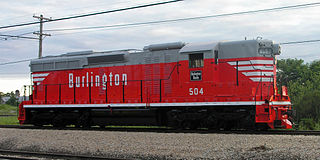
The EMD SD24 was a 2,400 hp (1,800 kW) six-axle (C-C) diesel-electric locomotive built by General Motors' Electro-Motive Division of La Grange, Illinois between July 1958 and March 1963. A total of 224 units were built for customers in the United States, comprising 179 regular, cab-equipped locomotives and 45 cabless B units. The latter were built solely for the Union Pacific Railroad.

LMS No. 10000 and 10001 were the first mainline diesel locomotives built in Great Britain. They were built in association with English Electric by the London, Midland and Scottish Railway at its Derby Works, using an English Electric 1,600 hp diesel engine, generator and electrics.
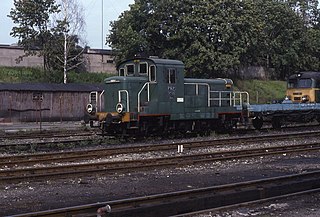
SM30 is a Polish series of diesel shunting locomotives used by PKP and industry, built by Fablok, Chrzanów. They were also used for a local traffic.

The M62 is a Soviet-built diesel locomotive for heavy freight trains, exported to many Eastern Bloc countries as well as to Cuba, North Korea and Mongolia. Beside the single locomotive M62 also twin versions 2M62 and three-section versions 3M62 have been built. A total number of 7,164 single sections have been produced, which have been used to build 5,231 single-, twin- and three-section locomotives.

SM42 is the PKP class for a Polish shunter diesel locomotive for shunting and light freight traffic, built by Fablok in Chrzanów.
SU46 is the name for a diesel universal purpose locomotive working for Polish PKP. Cegielski has produced 52 machines in years 1974-1977 and 2 modified in 1985.
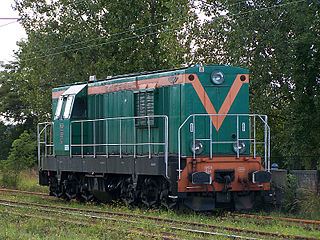
SM31 is a Polish series of diesel shunting locomotives used by PKP and industry.

SU42 is a Polish diesel-electric locomotive used for light freight and passenger traffic purposes.

SP45 is the name for a Polish diesel locomotive. It was built for the purpose of passenger traffic. No operating examples of this loco remain. All have been phased out or rebuilt into SU45.
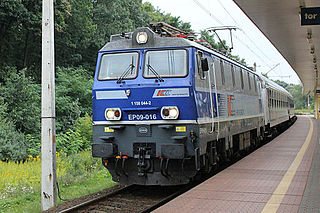
EP09 is a Polish electric locomotive used by the Polish railways, Polskie Koleje Państwowe (PKP) and produced by Pafawag of Wrocław between 1986 and 1997.

ET21 is a name for a Polish electric freight locomotive produced between years 1957 to 1971 in Pafawag. It was the first post-war Polish electric locomotive, designed in 1955. Besides being delivered for PKP, ET21 locomotives were delivered to the mining industry, where they are used up to now.
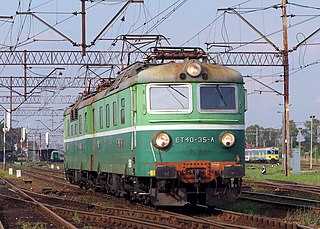
ET40 is the name for Bo′Bo′+Bo′Bo′ two-unit freight electric locomotive in service of Polish national rail operator, PKP. The locomotive was produced by Škoda Works in the Czechoslovakia.
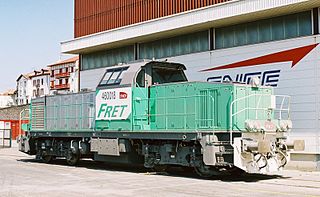
The SNCF class BB 60000 are a class of 4 axle heavy shunting and light freight diesel electric locomotives built at the Vossloh Espana works in Valencia. Since the class is primarily used as a freight locomotive the class is commonly referred to as SNCF BB460000.
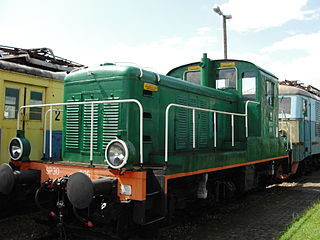
SP30 is a Polish series of diesel passenger locomotives used by PKP.

The Eurorunner family of locomotives are a series of medium- to high-power diesel-electric locomotives built by Siemens for the European market. Introduced from 2002 onwards, they share design characteristics with the successful Eurosprinter range of electric locomotives, also built by Siemens.

The Class D.445 is a class of diesel locomotives used by the Italian Ferrovie dello Stato (FS) railway company and by Trenord. 150 units were built between 1974 and 1988, divided into three series.

SNCF CC 70000 was a class of two prototype high power diesel-electric locomotives numbered CC 70001 and 70002. They were built at the same time as a diesel-hydraulic version, BB 69000.
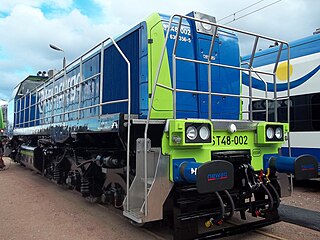
Newag 15D/16D is a cargo locomotive or broad gauge diesel locomotive rebuilt by Newag in Nowy Sącz in Poland, which is a deeply modernised SM48 locomotive.
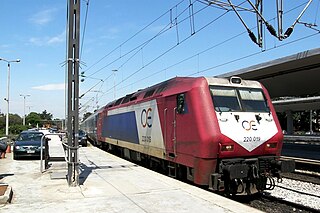
The OSE class 220, also known as DE2000 or Marlboro, due to the coloring of the front, reminiscent of the packaging colors of the homonymous tobacco industry, is a series of diesel-electric locomotives operated by TRAINOSE and RCLG and is part of the OSE fleet. It was built in 1998 at the ADTranz factories in Kassel, Germany, as the A.471 series, but in 2003 OSE acquired another batch. The locomotives were put into operation by OSE after the completion of their construction.